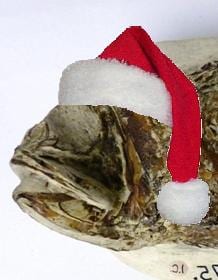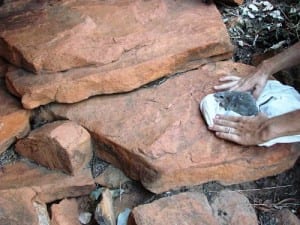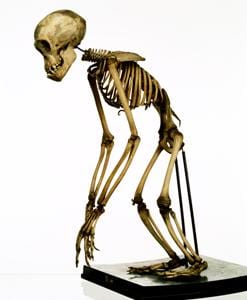Underwhelming Fossil Fish of the Month: December 2014
By Mark Carnall, on 19 December 2014
You’ll never be displayed
For the selection criteria of specimens
Isn’t biased in your way
To save us all from excitement
You’re here to save the day
O drawers of underwhelming fossil fish
Underwhelming fossil fish
O drawers o-hof underwhelming fossil fish.
It’s that time of the year when people of all walks of life come together to celebrate the passing of 12 months of underwhelming fossil fish and look forward to the next 12, hoping the fossils stay quietly unassuming, not too bombastic or boisterous and altogether middling-at-best. This year was particularly unexciting one for fossil fish with many stoically maintaining a state of fossiliferous.
The Glass Delusion
By ucwaemo, on 17 December 2014
‘Man, like all animals, is glass and can return to glass’ writes the German alchemist Johann Becher in his work Physica Subterranea published in 1669. Becher claimed that he had found the secret of turning dead bodies into transparent glass, so that we could surround ourselves with beautiful vases formed of our ancestors (preferable, he writes, to ‘hideous and disgusting cadavers’).
The glass of each animal and plant has its own particular colour – that of plants is green, while glass made from humans, he writes, is a milky white colour with ‘a slight tinge of narcissus’.
Becher, unfortunately, was wrong. Trace amounts of silicon, the element that is used in forming glass,* do exist in the human body through our diet (beer is one particularly good source) and may improve the health of bones – but it’s unclear exactly how it does this, or whether it’s biologically essential.** However, this hasn’t stopped a proliferation of claims for the benefits of silica supplements to make our teeth, hair, nails and skin stronger and more glassily beautiful.
Silicon is essential to some plants and animals, though, in particular those erose earlier in the evolution of life such as glass sponges, which use silica to grow their interlocking needle-like spicules.
As artist in residence here at the Grant Museum I’ve been focusing on the sponge collection and the ways in which a material can be both organic and inorganic – combining to form both a living animal and a glass jar. One aspect that particularly interests me is the history of humans believing that they are made of glass, a belief which spread amongst European scholars during the 15th to 17th century.
For Johann Becher, this fueled his desire to create glass vases from dead bodies. For others, however, it was a debilitating disorder known as ‘The Glass Delusion’. Sufferers believed that they were made from glass and would shatter at just one touch. It mainly afflicted wealthy men, and the most famous sufferer was perhaps King Charles VI of France who believed himself made entirely from glass and wore protective clothing to prevent being smashed to pieces.
For other sufferers it was mainly their head or buttocks that concerned them, so they avoided sitting down, or always carried a soft cushion. Why this belief spread during this period is unclear, but it had disappeared by the end of the 17th century, coinciding with the gradual replacement of alchemy with the emergence of modern chemistry.
However, as the current interest in silica supplements suggests, it seems there’s still a belief that glass may combine with and enhance the human body – not to shatter us, but to make us glow with a glassy transparency.
Image source: ‘The Magic and Myth of Alchemy’, Lloyd Library and Museum, 2011. www.lloydlibrary.org/exhibits/alchemy/alchemists.html. Accessed 12.12.2014.
* Silicon is an element that likes to share – in particular with oxygen. Rather than existing in its pure state, it tends to gives away or share its electrons with other elements, and this creates compounds. One of these compounds is silica, also known as silicon dioxide, which exists in sand – this is the stuff that is used to create glass.
** See R. Jugdaohsingh, ‘Silicon and bone health’, Journal of Nutritional Health and Aging. 11(2), Mar-Apr, 2007. 99-110.
Eleanor Morgan is Artist in Residence at the Grant Museum of Zoology
Specimen of the Week: Week 166
By Mark Carnall, on 15 December 2014
 Following on from last week’s focus on one of our specimens that will be receiving a spot of conservation TLC as part of our Bone Idols: Protecting Our Iconic skeletons conservation project, this week’s specimen is another specimen we’re looking to raise funds to conserve.
Following on from last week’s focus on one of our specimens that will be receiving a spot of conservation TLC as part of our Bone Idols: Protecting Our Iconic skeletons conservation project, this week’s specimen is another specimen we’re looking to raise funds to conserve.
This specimen is one of the largest* single specimens in the museum and sits in the heart of the displays. Although the specimen isn’t instantly recognisable, visitors I talk to about it are in reverance to it’s overall ‘bigness’ and after a few clues can identify what it is.
So pack your trunk and prepare never to forget this week’s specimen of the week which is…
On the search for the Scaly-tailed possum: Wet and Wildlife
By Jack Ashby, on 11 December 2014
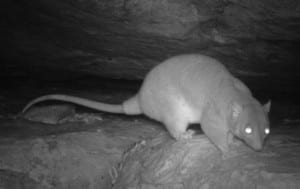
A scaly-tailed possum caught on a camera trap
in AWC’s Artesian Range.
(C) Australian Wildlife Conservancy,
Over the past few years I have been spending my spare time in a remote area of the Kimberley, on the northwest corner of Australia, helping a conservation NGO – the Australian Wildlife Conservancy (AWC) – to do ecological fieldwork. AWC are Australia’s largest private owner of land for conservation, and their mission is to manage it based on scientific research. In the northwest their big long-term projects involve determining the effects of cattle and different fire management practices on tropical savannah ecosystems. And in my most recent two trips I’ve been lucky enough to be involved in the detection of super-scarce species in extremely remote pockets of rainforest and monsoonal woodland.
A few years ago AWC acquired an amazing patch of the Kimberley called Artesian Range – monsoonal savannah criss-crossed with sandstone ranges, gorges of vine-thickets and rainforest pockets. I remember going through the first set of remote camera trap images that came back from Artestian in 2011 and being amazed at the species that were being detected.
The haven from extinction
It seems that Artesian Range is the only place in mainland Australia not to have suffered any mammal extinctions since European colonisation. A community of amazing endemics has clung on – scaly-tailed possums, golden-backed tree rats, monjons, golden bandicoots and Kimberley rock rats. When I was analyzing those camera trap images in 2011 I was a couple of hundred kilometres south of Artesian, on AWC Northwest’s main home sanctuary, Mornington. Artesian Range is in one of the least accessible parts of Australia, requiring a combination of propeller-plane, serious 4WD and helicopter to get to. As amazing as it was to see these species on the screen, I instantly knew I had to go and see them in the flesh. For me, the scaly-tailed possum had become the holy grail.
Read the rest of this entry »
Specimen of the Week: Week 165
By Jack Ashby, on 8 December 2014
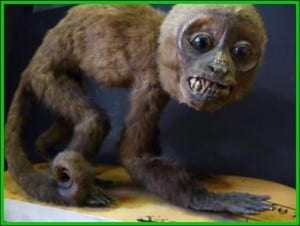 When Specimen of the Week first arose from its fossil ancestors in the Early Blogocene, the niche it originally occupied was to shed light on the darkest corners of our stored collections.
When Specimen of the Week first arose from its fossil ancestors in the Early Blogocene, the niche it originally occupied was to shed light on the darkest corners of our stored collections.
Over time, there has been some descent with modification. Specimen of the Week maintains its ancestral characters and still has the ability to show the world what museums have in their drawers; but it has also acquired some new adaptations where something amazing is revealed about well-known specimens. Some suspect sexual selection is at work.
This week, a new mutation has arisen. Instead of lifting the lid on stories from the stores, this Specimen of the Week will shed light on glimpses of horror in a specimen’s database records. Time will tell whether this adaptation will become fixed in the Specimen of the Week population.
This week’s Specimen of the Week is… Read the rest of this entry »
Specimen of the Week: Week 164
By Dean W Veall, on 1 December 2014
 Dean Veall here. This may be a very broad generalisation but Welsh, curly haired, zoology trained museum educators have limited knowledge about and skills in playing football, based on a recent survey conducted by me (n=1). This fact enrages and frustrates my four year old nephew as on weekends back in the Valleys when all he wants to do is run around Bargoed Park with a football. It hasn’t always been this way, there was a brief moment back in 2010 when the group that this week’s Specimen of the Week belonged to help me engage with the sport, that is, until it died.
Dean Veall here. This may be a very broad generalisation but Welsh, curly haired, zoology trained museum educators have limited knowledge about and skills in playing football, based on a recent survey conducted by me (n=1). This fact enrages and frustrates my four year old nephew as on weekends back in the Valleys when all he wants to do is run around Bargoed Park with a football. It hasn’t always been this way, there was a brief moment back in 2010 when the group that this week’s Specimen of the Week belonged to help me engage with the sport, that is, until it died.
This week’s Specimen of the Week is:
Dismantling Reg the Rhino in Ten Easy Steps
By Jack Ashby, on 27 November 2014
On 10th November the Grant Museum team took on the giant task of dismantling the largest specimen in the Museum – our huge (hornless) one-horned rhino skeleton. This is one of the first steps in our massive conservation project Bone Idols: Protecting our Iconic Skeletons (click the link to read more about it and how you can support it).
In this previous post I described the the history of this specimen and what conservation work will be done to this invaluable specimen. We also set a Twitter competition to #NameTheRhino – he shall now be known as Reg. Full details about that at the bottom.
How to take apart a complicated massive skeleton, in ten easy steps.
This was all coordinated by skeleton conservator Nigel Larkin.
1) Label every bone and photograph everything so Nigel knows where to put them when Reg gets rebuilt.
2) Set up a time-lapse camera to record the whole thing:
Underwhelming Fossil Fish of the Month: November 2014
By Mark Carnall, on 26 November 2014
It’s that time of year, reindeer who are different are being bullied by their peers, Jack Frost is biting noses again, Saturday morning TV is back to back toy adverts with the odd cartoon in between, Sainsbury’s remind us exactly why our ancestors fought and died in the Great War and Z list celebrities are turning lights on in high streets up and down the land. Yes of course, it’s November, a month so average they named it only once. But do you know what’s even less average than the month of November? It’s only UNDERWHELMING FOSSIL FISH OF THE MONTH, our monthly foray into the uninspiring world of forgotten fossil fish whose heyday, if they even had one, is long past. These fossiliferous fish now remain largely unused in museum stores and this blog series is a monthly window into their esoteric and marginal at best world.
Last months’ fossil fish proved too underwhelming for many leading to a number of network executives to hint that a third series of underwhelming fossil fish may not be forthcoming. To recompense and please the execs, I’m bringing out the big guns. I’ve chosen a pretty exciting fossil fish for November. We will get that third season fanatic fossil fish fans.
Do you need a PhD to be a curator?
By Nick J Booth, on 25 November 2014
During the ever excellent ‘Ask a Curator Day’ (search #AskACurator on twitter) I noticed a number of questions along the lines of ‘How do I become a curator’ / ‘what qualifications do I need to become a curator’. Many asked about whether a Masters in museum studies is sufficient. This is an ongoing debate on this blog and I suspect the question has no firm answer; however one response to this question from a national museum here in the UK caught my eye…
‘Museum Studies graduates do find curator jobs but increasingly employers are looking for PhD training in a speciality area.”
This is an interesting answer, and I am sure it is correct for national museums (or that one in particular at least), however I do not believe that it is correct for many, or even most, jobs with ‘curator’ in the title. So I thought I would briefly go through my experiences of the word ‘curator’ and what I perceive it to mean in the different areas of the museum world.
Grant Museum starts major project to preserve rarest skeleton in the world
By Jack Ashby, on 24 November 2014
Something very exciting has started here at the Grant. We are undertaking a major project to protect 39 of our rarest and most significant skeletons, some which have been on display in the Museum for 180 years. To help achieve this, we launching our first ever public fundraising campaign – aiming to raise £15,000 to support the costs of this crucial work.
Preserving the rarest skeleton in the world
The specimens include the rarest skeleton in the world: the extinct quagga – an unusual half-striped zebra from South Africa. It is the only mounted quagga skeleton in the UK, and no more than seven quagga skeletons survive globally. The project involves completely dismantling and chemically cleaning the irreplaceable skeleton, and then remounting it on a new skeleton-friendly frame in a more anatomically correct position. The work is intended to secure the long-term preservation of the specimens.
Protecting the uncollectable
The quagga will be the focus and most involved element of Bone Idols: Protecting our iconic skeletons, a major project of conservation across the Museum’s displays. Interventions will range from deep cleaning bones, repairing damaged elements and re-casing specimens through to remounting huge skeletons. Read the rest of this entry »
 Close
Close


